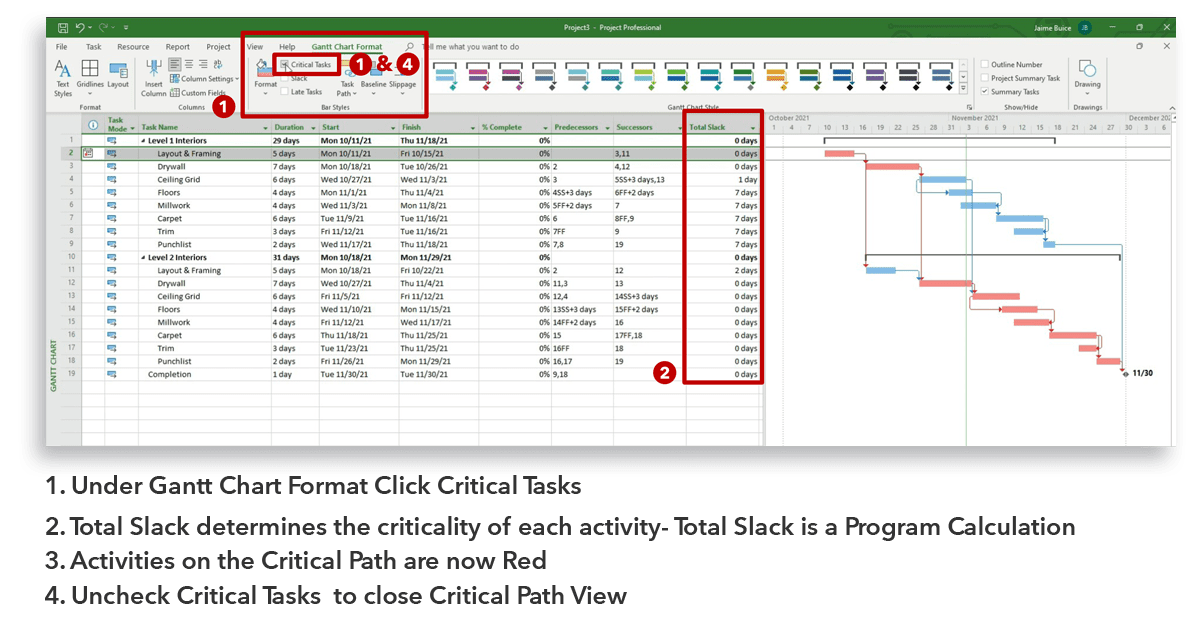Microsoft Project is a powerful project management tool designed to assist in planning, executing, and tracking projects of various sizes and complexities. As a construction professional, gaining a comprehensive understanding of
Microsoft Project can significantly contribute to the success of your projects.
Here's a detailed look at key aspects of Microsoft Project:
1. User-Friendly Interface
Microsoft Project features an intuitive and user-friendly interface that allows users to navigate through tasks, timelines, and resources effortlessly. The Ribbon interface provides quick access to various tools and functions, making it accessible for both beginners and experienced project managers.
2. Task and Resource Management
In
Microsoft Project, tasks are the building blocks of a project. You can create, assign, and track tasks, and establish dependencies to ensure a logical flow. The software also allows for efficient resource management by assigning resources to specific tasks, tracking resource allocation, and avoiding overloads.
3. Gantt Charts for Visualization
One of the standout features of
Microsoft Project is its dynamic Gantt chart view. This visual representation of tasks and their timelines provides a clear overview of the project schedule. Tasks are displayed as bars along a timeline, allowing project managers to identify dependencies, critical paths, and potential bottlenecks.
4. Customization and Templates
Microsoft Project offers a high level of customization, allowing users to tailor their project plans according to specific requirements. Additionally, the software provides templates for common project types, saving time and ensuring consistency across projects.
5. Resource and Cost Tracking
Efficient resource and cost tracking are crucial for project success.
Microsoft Project enables real-time tracking of resource usage and associated costs. This feature aids in budget management and ensures that projects stay on track financially.Understanding these features empowers construction professionals to leverage
Microsoft Project for precise construction scheduling. Whether you're managing timelines, allocating resources, or tracking progress,
Microsoft Project provides the tools needed to enhance project precision and overall success.
Setting Up a Project in Microsoft Project
Initiating a construction project in
Microsoft Project is a pivotal first step toward achieving precision in scheduling. The following guide outlines the key steps for setting up a project efficiently:
1. Project Information
Begin by defining the basic project information. This includes the project name, start date, and finish date. Setting the project start date establishes the foundation for the project timeline.
2. Task Creation
Create a comprehensive list of tasks that need to be completed for the construction project. Break down the project into manageable components, such as foundation, framing, plumbing, electrical work, and finishing. Each task should have a clear description and estimated duration.
3. Milestones and Deliverables
Identify significant milestones and deliverables within the project timeline. Milestones are key points that signify the completion of a phase or a critical task. Clearly defining these points helps in tracking progress and ensuring the project stays on schedule.
4. Task Dependencies
Establish dependencies between tasks to create a logical sequence of activities. Some tasks may be dependent on the completion of others, and
Microsoft Project allows you to designate these relationships. This ensures that tasks are executed in the correct order, preventing delays.
5. Resource Assignment
Allocate resources to each task based on availability and skill sets.
Microsoft Project allows you to assign team members, equipment, and materials to specific tasks. This step is crucial for resource optimization and efficient project execution.
6. Duration and Work Estimates
Enter estimated durations for each task, specifying the amount of work required.
Microsoft Project calculates the project schedule based on these inputs, allowing for realistic timeframes and workload distribution among team members.
7. Critical Path Analysis
Identify the critical path in your project schedule. The critical path is the sequence of tasks that determines the overall duration of the project. Understanding and managing the critical path is essential for avoiding delays and ensuring project precision.By meticulously setting up your construction project in
Microsoft Project, you lay the groundwork for a well-organized and precisely scheduled endeavor. This initial planning phase is instrumental in avoiding potential pitfalls and contributes to the overall success of the construction project.
Assigning Resources and Dependencies
Efficiently managing resources and dependencies is a crucial aspect of construction scheduling in Microsoft Project. Here's a comprehensive guide on assigning resources and establishing dependencies to ensure a seamless project flow:
1. Resource Allocation
Begin by assigning resources to each task in your project. Resources can include team members, equipment, and materials. Clearly define who is responsible for each task and ensure that resources are allocated based on availability and skill sets. This step is essential for optimizing workforce efficiency.
2. Resource Leveling
Utilize the resource leveling feature in Microsoft Project to balance workloads and prevent resource overloads. This ensures that no individual or team is overwhelmed with tasks while others remain underutilized. Resource leveling contributes to a more equitable distribution of work throughout the project timeline.
3. Task Dependencies Revisited
Review and refine task dependencies based on resource availability. Adjust dependencies to account for any constraints related to resource allocation. Microsoft Project allows you to easily modify dependencies to reflect changes in project dynamics, ensuring that tasks are completed in the most efficient order.
4. Resource Costs and Budgeting
Assign costs to resources and track budgetary aspects of the project. Microsoft Project facilitates the calculation of resource costs based on hourly rates or fixed costs. Monitoring resource costs is integral to staying within budget constraints and maintaining financial control throughout the construction project.
5. Visualizing Resource Allocation with Tables and Charts
Use tables and charts in Microsoft Project to visualize resource allocation and dependencies. The software offers various views, including Resource Usage and Resource Sheet, which provide insights into resource assignments and associated tasks. Visual representations enhance project managers' ability to make informed decisions.
6. Communication and Collaboration
Encourage open communication among team members regarding resource assignments and dependencies. Microsoft Project facilitates collaboration by allowing team members to access and update project information. Effective communication ensures that everyone is on the same page, reducing the risk of misunderstandings or delays.Assigning resources and managing dependencies are pivotal tasks in construction scheduling. By leveraging the features of Microsoft Project, project managers can optimize resource utilization, maintain project precision, and ensure that the construction project progresses smoothly from start to finish.
Utilizing Advanced Features
Microsoft Project offers a range of advanced features that can elevate construction scheduling to new levels of efficiency and precision. Let's explore these features and how they contribute to the successful management of construction projects:
1. Critical Path Analysis
One of the key advanced features in Microsoft Project is the ability to conduct a critical path analysis. The critical path represents the sequence of tasks that directly impact the project's overall duration. By identifying the critical path, project managers can prioritize these tasks to prevent delays and ensure timely project completion.
2. Resource Leveling and Optimization
Building on the basics of resource allocation, Microsoft Project's resource leveling feature enables the optimization of resource usage. It helps in balancing workloads, avoiding resource overloads, and ensuring a more even distribution of tasks. Resource optimization contributes to a smoother workflow and enhances overall project efficiency.
3. Custom Fields and Formulas
Custom fields allow project managers to tailor Microsoft Project to their specific needs. Users can create custom fields for tasks, resources, and assignments, incorporating unique data relevant to the construction project. Formulas can be applied to these custom fields for calculations, providing a high degree of flexibility in project tracking and reporting.
4. Earned Value Analysis
Microsoft Project supports earned value analysis, a project management technique that assesses a project's performance in terms of planned value, earned value, and actual cost. This advanced feature provides insights into project cost and schedule performance, enabling project managers to make informed decisions and adjustments as needed.
5. Visual Reports and Dashboards
Enhance project communication and reporting with visual reports and dashboards. Microsoft Project allows users to create graphical representations of project data, such as Gantt charts, pie charts, and histograms. These visualizations make it easier for stakeholders to understand project progress and performance at a glance.
6. Collaboration with SharePoint Integration
Integrate Microsoft Project with SharePoint for improved collaboration and document management. SharePoint integration allows team members to access project documents, share updates, and collaborate seamlessly. This advanced feature fosters a collaborative environment, reducing communication barriers and enhancing overall project coordination.By leveraging these advanced features in Microsoft Project, construction project managers can go beyond basic scheduling and embrace a more sophisticated approach to project management. These tools empower project teams to tackle complex challenges, optimize resources, and achieve greater precision in construction project scheduling.
Overcoming Challenges in Construction Scheduling
Construction scheduling is inherently complex, and project managers often encounter various challenges that can impact project timelines and outcomes. Identifying and addressing these challenges is crucial for maintaining project precision. Let's explore common challenges and effective strategies for overcoming them:
1. Unforeseen Delays and Changes
Challenge: Unforeseen delays, such as weather disruptions or unexpected design changes, can significantly impact construction schedules.
Solution: Build contingency buffers into the schedule to accommodate potential delays. Regularly review and update the schedule as new information becomes available, and communicate changes to all stakeholders promptly.
2. Resource Constraints
Challenge: Resource constraints, whether due to limited manpower or material shortages, can lead to scheduling bottlenecks.
Solution: Utilize resource leveling in Microsoft Project to optimize resource allocation. Collaborate with suppliers to ensure a steady flow of materials and proactively address potential resource shortages.
3. Communication Gaps
Challenge: Communication gaps among team members and stakeholders can result in misunderstandings and coordination issues.
Solution: Foster open communication channels, use collaboration tools, and consider regular project status meetings. Integrating Microsoft Project with communication platforms can enhance real-time updates and ensure everyone is on the same page.
4. Scope Creep
Challenge: Scope creep, the gradual expansion of project scope beyond its initial boundaries, can lead to schedule overruns.
Solution: Clearly define project scope from the outset and establish a formal change control process. Regularly review project scope to identify and address any unauthorized changes promptly.
5. Technology Adoption Challenges
Challenge: Resistance to adopting new technologies, including project management tools like Microsoft Project.
Solution: Provide training and support to team members to ensure a smooth transition to new technologies. Highlight the benefits of using advanced project management tools, such as improved efficiency and better decision-making capabilities.
6. Inaccurate Estimations
Challenge: Inaccurate estimations of task durations and resource requirements can lead to unrealistic schedules.
Solution: Regularly review and refine estimations based on project progress and feedback. Utilize historical data from previous projects to improve the accuracy of future estimations.Successfully overcoming these challenges requires a proactive and adaptive approach. By implementing effective strategies and leveraging the features of tools like Microsoft Project, construction project managers can navigate complexities, maintain project precision, and ensure successful project delivery.
FAQ
Explore answers to frequently asked questions about construction scheduling and using Microsoft Project for project precision:
Q: How does Microsoft Project help in construction scheduling?
A: Microsoft Project is a robust project management tool that aids in planning, executing, and tracking construction projects. It allows users to create detailed schedules, assign resources, manage dependencies, and optimize project timelines for greater precision.
Q: What is the critical path in construction scheduling?
A: The critical path in construction scheduling is the sequence of tasks that determines the overall duration of the project. Tasks on the critical path are essential for project completion, and any delays in these tasks will impact the project's timeline. Microsoft Project helps identify and manage the critical path for optimal project control.
Q: How can resource leveling benefit construction projects?
A: Resource leveling in Microsoft Project involves balancing workloads to prevent resource overloads and ensure a more even distribution of tasks. This benefits construction projects by optimizing resource usage, reducing bottlenecks, and contributing to a smoother project flow, ultimately enhancing efficiency and precision.
Q: Can Microsoft Project handle changes and delays in construction projects?
A: Yes, Microsoft Project is equipped to handle changes and delays in construction projects. Project managers can update task dependencies, adjust timelines, and communicate changes efficiently. The software's flexibility allows for real-time adjustments, ensuring the construction schedule remains accurate and adaptable to project dynamics.
Q: How can collaboration be improved in construction scheduling using Microsoft Project?
A: Microsoft Project facilitates collaboration by integrating with platforms like SharePoint. This integration enables team members to access project documents, share updates, and collaborate seamlessly. Improved communication tools within Microsoft Project also enhance team coordination, reducing the risk of miscommunication and delays.
Q: Is Microsoft Project suitable for small construction projects?
A: Yes, Microsoft Project is suitable for both small and large construction projects. Its scalability allows users to tailor project management features based on the project's size and complexity. The software's user-friendly interface and customizable options make it accessible for smaller construction teams while offering advanced functionalities for more extensive projects.Explore these FAQs to gain insights into construction scheduling best practices and the effective use of Microsoft Project for achieving project precision.
Conclusion
In conclusion, mastering the art of construction scheduling with Microsoft Project opens up a world of possibilities for project precision. Throughout this blog post, we've explored the key stages of creating a construction schedule, from setting up a project and assigning resources to utilizing advanced features and overcoming common challenges. The journey toward project precision involves leveraging the robust tools offered by Microsoft Project.By understanding the user-friendly interface, embracing task dependencies, and optimizing resource allocation, construction professionals can create detailed and efficient schedules. The advanced features of Microsoft Project, such as critical path analysis and earned value analysis, provide insights that go beyond basic scheduling, enabling project managers to make informed decisions and keep projects on track.Overcoming challenges, whether they be unforeseen delays, resource constraints, or communication gaps, requires a proactive approach. Microsoft Project empowers project managers to address these challenges head-on, fostering collaboration, ensuring accurate estimations, and providing the flexibility needed to adapt to changing project dynamics.In the ever-evolving landscape of construction project management, Microsoft Project stands as a versatile and indispensable tool. Whether you're overseeing a small-scale construction project or a large, complex endeavor, the scalability and customization options of Microsoft Project make it adaptable to your specific needs.As construction professionals embrace the capabilities of Microsoft Project, they not only streamline the scheduling process but also enhance overall project efficiency, communication, and success. Project Precision becomes more than just a goal—it becomes a reality that transforms construction scheduling into a well-orchestrated and precisely executed endeavor.In your journey towards achieving Project Precision, remember that continuous learning, collaboration, and leveraging the advanced features of Microsoft Project are key ingredients for success. Here's to constructing a future where every project is a testament to meticulous planning, optimal resource utilization, and unwavering project precision.


 admin
admin








